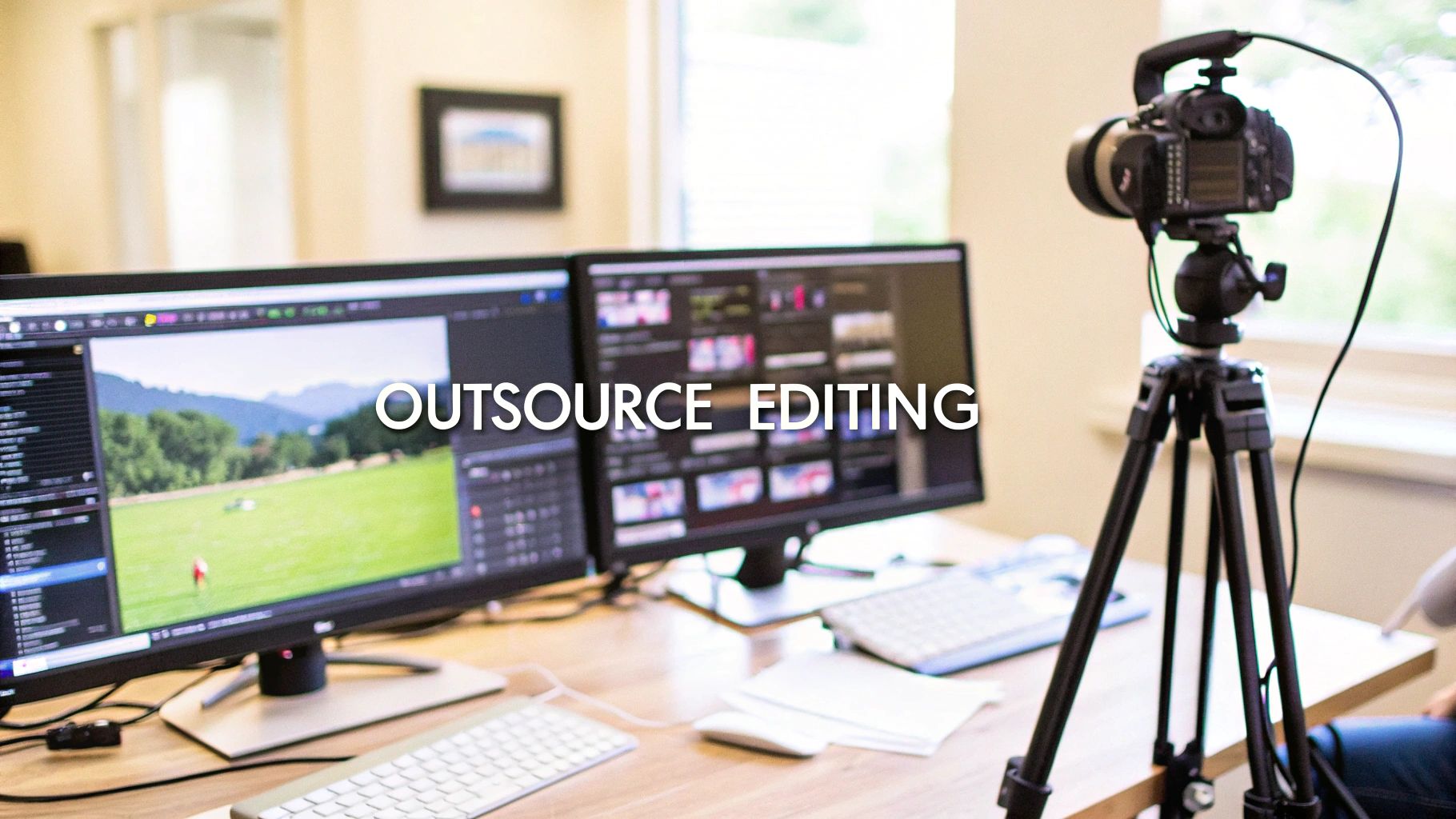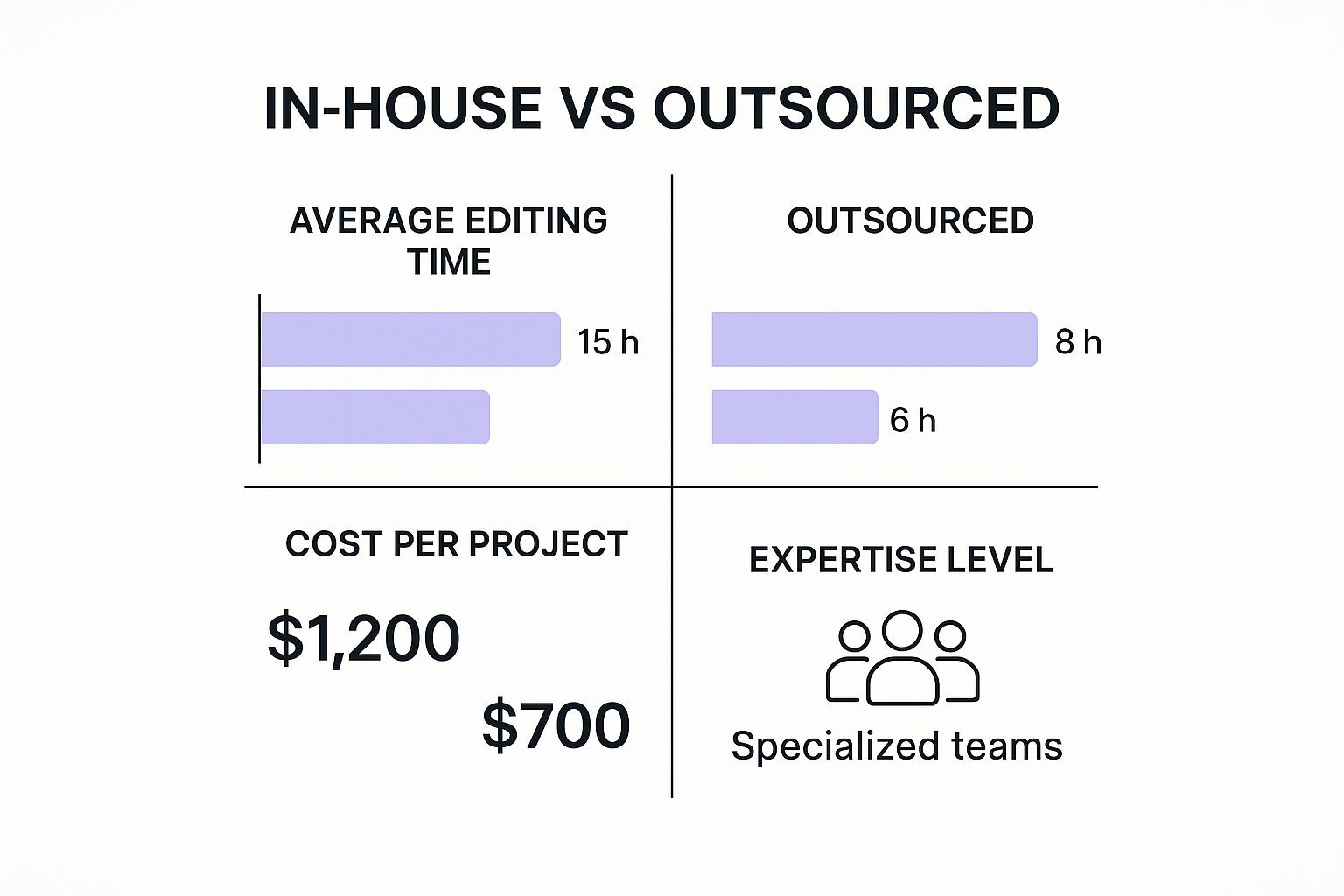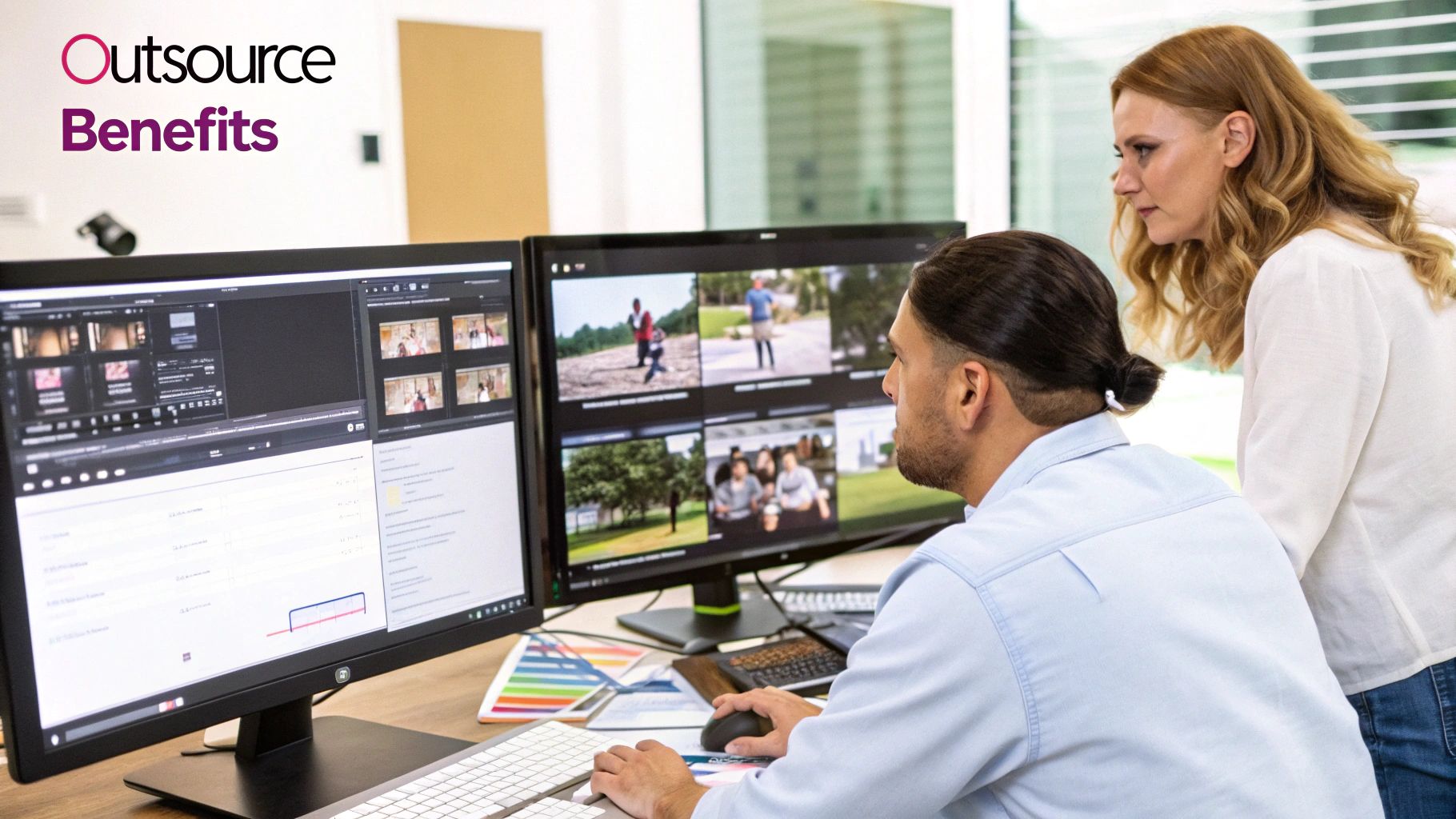
Video editing outsourcing is the practice of hiring external freelancers or agencies to handle your video post-production. It's much more than a cost-cutting tactic; it's a strategic move to scale content production, keep quality high, and let your in-house team focus on what they do best: growing your brand.
For many brands focused on growth, the demand for high-quality video content is relentless. Trying to keep up with an in-house team can quickly feel like you're fighting a losing battle against time, budget, and burnout. This is where video editing outsourcing becomes less about delegating a task and more about adopting a core business strategy.
Think of your in-house team as the skilled chefs in a restaurant kitchen, experts at handling the daily menu. But what happens when you need to cater a massive banquet for 500 people without sacrificing quality? You bring in a specialized, world-class catering team. Outsourcing video editing works on the same principle—it gives you access to specialized skills and a huge production capacity, exactly when you need it.
One of the biggest wins from outsourcing is tapping into external expertise. This allows your business to implement proven strategies for scaling content creation far more efficiently. Instead of your creative director sinking 15 hours into a single complex edit, they can stay focused on high-level strategy and planning the next big campaign.
This approach unlocks several key advantages:
Outsourcing has exploded in popularity, especially as video has taken over the internet. With over 82% of all internet traffic now being video, businesses are turning to external partners to meet the massive demand. Many are finding they can cut post-production costs by up to 40% compared to hiring full-time editors.
Here's a quick look at how in-house and outsourced editing stack up.
| Factor | In-House Editing | Video Editing Outsourcing |
|---|---|---|
| Cost Structure | Fixed costs (salary, benefits, overhead) | Variable, pay-per-project or retainer |
| Speed & Scalability | Limited by team size and workload | Highly scalable; access to larger teams |
| Talent & Skills | Limited to the skills of your team | Access to a global pool of specialists |
| Management | Direct, hands-on management required | Managed by an external partner or PM |
| Flexibility | Less flexible; difficult to scale down | Highly flexible; adjust as needed |
This table makes it clear: outsourcing offers a level of agility that's tough for most in-house teams to match.
The infographic below really drives home the differences in time, cost, and expertise between the two models.

As you can see, outsourcing doesn't just trim project costs and shorten timelines; it provides immediate access to specialized teams ready to hit the ground running. This strategic shift empowers companies to scale efficiently, a concept we explore further in our guide on https://lathire.com/why-hiring-remote-workers-from-latam-is-a-smart-business-move/.
By offloading the technical, time-consuming work of post-production, you free up your core team to do what they were hired for: innovate and grow your brand.

Finding the right creative partner is, without a doubt, the most critical part of outsourcing your video editing. The perfect editor doesn't just slice clips together; they become an extension of your brand, someone who instinctively gets your vision and knows how to make your content shine.
This isn't about getting lucky. It’s about a deliberate process of sourcing, evaluating, and testing talent to find a genuine partner for your brand.
The talent pool for video editors is enormous, but not all sources are created equal. Where you decide to look will directly shape the type of professional you find, how much they'll cost, and the amount of day-to-day management you'll need to do.
Popular Talent Marketplaces:
Sourcing from specific regions can also give you a major leg up. For example, exploring options for hiring skilled remote video editors from LatAm gives you access to a world-class talent pool that works on a similar schedule to North American companies, but at a more competitive cost.
So you’ve got a shortlist of candidates. Now the real work begins. A flashy portfolio can easily fool you, so your job is to look past the highlight reel and dig into the subtle details that matter for your brand. Remember, a great editor is a great storyteller.
When you review a portfolio, don't just watch—analyze.
The most critical mistake businesses make is hiring based on a portfolio alone. A portfolio shows what an editor can do, but a trial project shows what they will do for you—revealing their communication style, reliability, and ability to take direction.
Once you've narrowed your list based on their work, it's time for a brief interview. This is your chance to see if they're professional, how they communicate, and whether they truly understand what you're trying to achieve.
Key Interview Questions to Ask:
The final, non-negotiable step is the paid trial project. Never, ever ask for free work. Instead, commission a small but real task. This could be editing a two-minute segment of a longer video or creating a 30-second social media clip from footage you provide.
This test achieves what no portfolio or interview can: it shows you exactly how the editor works. You’ll see how well they interpret your creative brief, how they communicate during the process, and if they can deliver a polished final product on schedule. It's a small investment that saves you from the massive headache of a bad long-term hire, ensuring your outsourcing strategy is built on a foundation of proven talent.

Getting great results from an outsourced video editor all comes down to having a great process. Just dumping raw footage on someone and hoping for the best is a fast track to missed deadlines, endless revisions, and a whole lot of frustration. The secret to a successful partnership is building a predictable, efficient, and crystal-clear workflow.
Think of it like building with LEGOs. If you hand someone a box of bricks without instructions, they might create something interesting, but it probably won’t be the castle you had in mind. A solid workflow is your instruction manual, making sure your editor builds exactly what you need, every single time.
This structured approach is what makes modern business tick. In fact, the global outsourcing market is proof, with spending predicted to hit $1,138 billion. That staggering number shows just how much companies rely on outside experts, and it’s a bulletproof workflow that separates the successful partnerships from the failures.
The creative brief is the single most important document in your entire workflow. Seriously. It’s the foundation for every single cut, transition, and color grade. A vague brief guarantees a vague video, so your goal here is to stamp out any and all ambiguity right from the start.
A great brief doesn't just list tasks; it transfers your vision. It needs to clearly explain the video's core message, who it's for, and the exact feeling you want viewers to walk away with.
Make sure your brief nails these points:
Effective video editing outsourcing hinges on having the right tools to close the distance between you and your editor. Trying to send massive video files back and forth over email just isn't going to cut it. You need a professional tech stack built for creative collaboration.
Essential Tools for Your Workflow:
Your workflow isn't just a process; it's a communication system. By providing clear instructions and using the right tools, you empower your editor to succeed, which means fewer revisions and a faster path to the final product you envisioned.
Let's say you run a weekly YouTube series. Here’s what your outsourced workflow could look like:
This simple, repeatable system creates predictability and kills the guesswork. When you truly master your content creation workflow, you transform a simple transaction into a smooth-running content machine.

Let's talk money. Figuring out the financial side of outsourcing video editing is the key to making a smart investment. Unlike the fixed, predictable salary of an in-house employee, outsourcing gives you flexible pricing structures that can grow—or shrink—right along with your content needs.
The cost isn't just a number; it’s a direct reflection of skill, speed, and the scope of your project. Before you dive in, it’s worth getting familiar with typical freelance video editing rates to build a realistic budget.
When you start looking for an external video editor, you'll generally run into three main ways they charge for their work. Each model fits different types of projects and content volumes, so picking the right one can make a huge difference to your bottom line.
The price tag on video editing isn't pulled out of thin air. No matter which pricing model you choose, a few key variables will always shape the final quote you receive.
A common mistake is to just shop for the lowest price without thinking about the hidden costs. An inexperienced editor might charge less per hour, but if they take three times as long, you end up paying more in both money and time.
Here are the main drivers behind what you'll pay:
To give you a clearer picture, here’s a look at how these models typically break down by experience level.
| Pricing Model | Beginner/Intermediate Rate | Expert/Agency Rate | Best For |
|---|---|---|---|
| Hourly Rate | $25 – $60 / hour | $75 – $150+ / hour | One-off tasks, uncertain scope, quick revisions. |
| Per-Project Fee | $200 – $800 / video | $1,000 – $5,000+ / video | Repeatable projects with a clear, defined scope. |
| Monthly Retainer | $1,000 – $4,000 / month | $5,000 – $10,000+ / month | Consistent, high-volume content needs and ongoing work. |
Keep in mind these are general ranges. A highly specialized project, like a feature-length documentary or a Super Bowl commercial, would naturally fall well outside these estimates.
The real financial magic of outsourcing becomes crystal clear when you stack it up against the full cost of hiring an in-house editor. A salary is just the starting point. You also have to factor in benefits, payroll taxes, expensive software licenses (Adobe Creative Cloud is over $600/year per user), and the powerful hardware needed to handle professional video files.
Outsourcing flips this model on its head. It turns large, fixed capital expenses into a flexible operational cost. You only pay for what you need, right when you need it. This approach doesn't just scale with your business; it can be incredibly cost-effective, particularly when you source talent from different regions. You can learn more about the cost-effectiveness of hiring remote talent from LatAm to see how this plays out in the real world.
Ultimately, this flexibility lets you maintain high-quality video production without the heavy, long-term financial burden of a full-time employee.
Outsourcing your video editing can be a game-changer for your content production, but a few common missteps can easily derail the whole process. Learning to sidestep these pitfalls is the fastest way to build a strong partnership that saves you time, money, and a whole lot of frustration.
https://www.youtube.com/embed/gOchfGvTogk
The biggest mistake often happens right at the start: diving in without a clear plan. Too many creators and businesses hire an editor simply because they feel overwhelmed, but they haven't stopped to pinpoint the exact tasks that are draining their time and energy. This leads to vague roles and mismatched expectations before the work even begins.
Instead of just looking for a generic "editor," take a moment to analyze your own workflow. Do you absolutely dread designing thumbnails? Does the research phase get you bogged down? Identifying the specific bottlenecks helps you find someone with the perfect skills for the job.
One of the most frequent errors we see is handing off a hard drive of footage with a fuzzy, incomplete creative brief. An instruction like "make this look professional" is a recipe for disaster. It’s open to a dozen different interpretations and almost guarantees you'll get a first draft that completely misses the mark.
A detailed brief isn't just a suggestion; it’s your project’s blueprint. It eliminates guesswork and empowers your editor to bring your vision to life accurately on the first try.
To avoid this, make sure your brief includes:
Think of it this way: you wouldn't ask a builder to "build a nice house" without blueprints. Your creative brief is the blueprint for your video, ensuring a solid final structure.
Another critical error is failing to set up clear communication channels from day one. When feedback is scattered across messy email threads, comments get missed, notes contradict each other, and you're stuck in a frustrating cycle of endless revisions. It’s a nightmare for everyone involved.
Establish a single source of truth for all project communication. A project management tool like Slack is great for quick updates and questions, while a dedicated video review platform like Frame.io is essential for precise, time-stamped feedback directly on the video. This simple step keeps everyone on the same page and makes the revision process smooth and efficient.
Finally, don't treat intellectual property as an afterthought. Always have a clear contract or freelance agreement that spells out who owns the raw footage and the final, edited product. For sensitive projects, a Non-Disclosure Agreement (NDA) is also a must. Protecting your assets isn’t just red tape; it’s a foundational part of any professional outsourcing relationship.
Of course. Here is the rewritten section, crafted to sound like it was written by an experienced human expert, following all the provided style and formatting guidelines.
Even when you've got a solid plan, a few practical questions always pop up before you pull the trigger on outsourcing. Let’s tackle the big ones I hear from creators and businesses all the time, so you can move forward without any lingering doubts.
This is probably the most important question, and thankfully, the answer is straightforward. Never, ever start a project without a solid legal agreement. This could be a freelance contract or a more formal statement of work, but it absolutely must state that you retain 100% ownership of all raw footage and the final, edited video.
For projects with sensitive information, I always recommend taking it a step further with a Non-Disclosure Agreement (NDA). Any true professional won't bat an eye at this; in fact, they’ll see it as a sign that you’re serious and organized. Finally, stick to secure, professional file transfer services for sharing your assets.
Peace of mind comes from clear legal agreements. A simple contract and an NDA aren't just formalities—they're standard business practices that shield your creative work from being misused or shared without your permission.
Turnaround time is all about complexity. If we're talking about a standard 10-minute YouTube video—basic cuts, some simple on-screen text, and standard color correction—a good editor can usually get a first draft back to you within 2-4 business days.
But if your vision involves more heavy lifting, like detailed motion graphics, multi-camera syncing, or a complex audio mix, the timeline will naturally stretch. The secret is to hash out all deadlines and deliverables before the work kicks off. That way, everyone is on the same page from the start.
This choice really boils down to two things: your project volume and how hands-on you want to be.
If you’re just starting your video editing outsourcing journey, my advice is almost always the same: find a great, well-vetted freelancer. It’s the smartest and most manageable way to begin.
